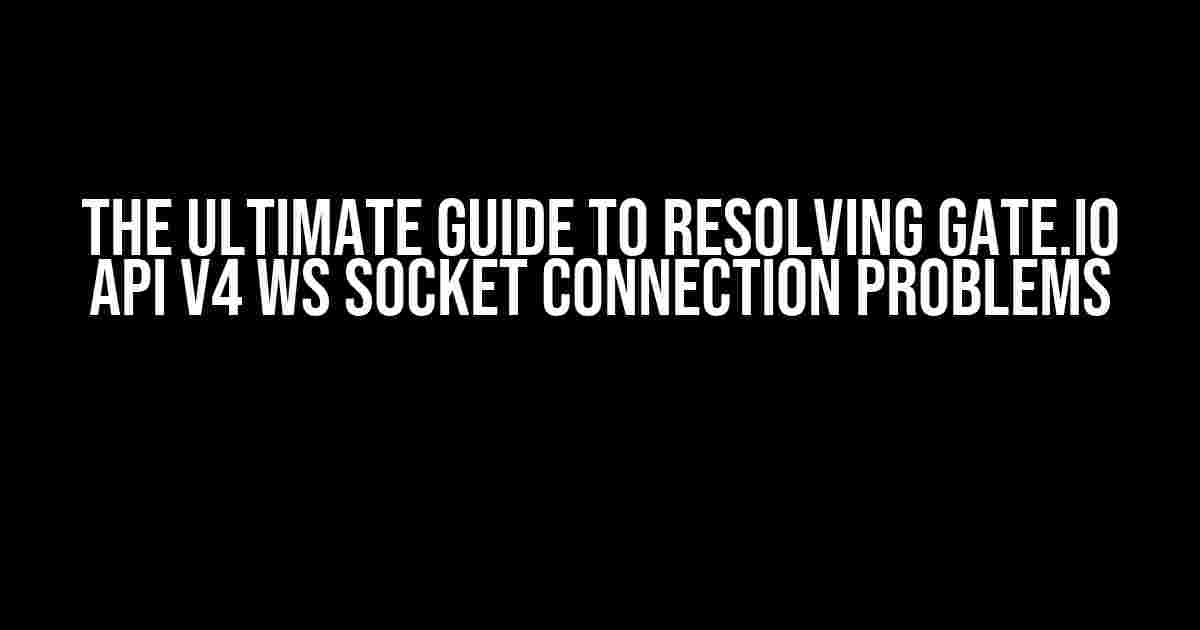Are you tired of dealing with frustrating connection issues while trying to access the Gate.io API v4 via WebSocket (WS) protocol? You’re not alone! Many developers have encountered this problem, but fear not, dear reader, for we have got you covered. In this comprehensive guide, we’ll dive into the common causes of Gate.io API v4 WS socket connection problems and provide you with step-by-step solutions to get you back on track.
Understanding the Gate.io API v4 WS Socket Connection
Before we dive into the troubleshooting process, it’s essential to understand how the Gate.io API v4 WS socket connection works. The WebSocket protocol is a bi-directional, real-time communication protocol that enables efficient and fast data exchange between the client (your application) and the server (Gate.io API v4). This protocol is particularly useful for applications that require real-time data updates, such as cryptocurrency trading platforms.
How to Establish a Gate.io API v4 WS Socket Connection
To establish a WS socket connection with the Gate.io API v4, you’ll need to follow these general steps:
- Obtain an API key and secret key from the Gate.io API v4 dashboard.
- Install a WebSocket library or framework that supports the WS protocol (e.g., WebSocket.js, ws-js, or Socket.IO).
- Establish a WS connection using the API key and secret key.
- Subscribe to the desired channels or endpoints to receive real-time data updates.
Common Causes of Gate.io API v4 WS Socket Connection Problems
Now that you’ve established a basic understanding of the Gate.io API v4 WS socket connection, let’s explore the common causes of connection problems:
1. Incorrect API Key or Secret Key
One of the most common mistakes is entering an invalid or incorrect API key or secret key. Double-check that you’ve copied the correct credentials from the Gate.io API v4 dashboard.
2. Incompatible WebSocket Library or Framework
Using an outdated or incompatible WebSocket library or framework can lead to connection issues. Ensure that you’re using a compatible library or framework that supports the WS protocol.
3. Network Connectivity Issues
Network connectivity problems can prevent your application from establishing a WS socket connection. Check your internet connection, firewall settings, and proxy configurations to ensure that they’re not blocking the connection.
4. Insufficient Permissions or Rate Limiting
If you’ve exceeded the allowed rate limits or lack sufficient permissions, the Gate.io API v4 may reject your connection requests. Review the API documentation to ensure that you’re within the allowed limits and have the necessary permissions.
5. Server-Side Issues
Sometimes, server-side issues can cause connection problems. Check the Gate.io API v4 status page or social media channels for any reported outages or maintenance schedules.
Troubleshooting Gate.io API v4 WS Socket Connection Problems
Now that we’ve covered the common causes of connection problems, let’s dive into the troubleshooting process:
Step 1: Verify API Key and Secret Key
const apiKey = 'YOUR_API_KEY';
const secretKey = 'YOUR_SECRET_KEY';
if (!apiKey || !secretKey) {
console.error('Invalid API key or secret key');
return;
}
First, verify that you’ve entered the correct API key and secret key. You can do this by logging into the Gate.io API v4 dashboard and checking your credentials.
Step 2: Check WebSocket Library or Framework Compatibility
const WebSocket = require('ws');
if (!WebSocket) {
console.error('WebSocket library not found');
return;
}
Next, ensure that you’re using a compatible WebSocket library or framework. Check the library’s documentation to ensure that it supports the WS protocol.
Step 3: Troubleshoot Network Connectivity Issues
const socket = new WebSocket('wss://api.gateio.ws/v4/ws');
socket.on('error', (error) => {
console.error(`Error establishing connection: ${error}`);
});
Use the WebSocket `error` event to catch any network connectivity issues. Check your internet connection, firewall settings, and proxy configurations to ensure that they’re not blocking the connection.
Step 4: Check API Permissions and Rate Limits
const apiPermissions = {
'ws': ['ticker', 'orderBook', 'trade'],
};
if (!apiPermissions.ws.includes('ticker')) {
console.error('Insufficient permissions for ws channel');
return;
}
Review the Gate.io API v4 documentation to ensure that you have the necessary permissions and are within the allowed rate limits.
Step 5: Check Server-Side Issues
const GateioAPI = require('gateio-api');
const api = new GateioAPI();
api.ping().then((response) => {
console.log('Server is online');
}).catch((error) => {
console.error('Server-side issue: ${error}');
});
Use the Gate.io API v4 ping endpoint to check if the server is online and responding to requests. If the server is down, try checking the status page or social media channels for updates.
Conclusion
Resolving Gate.io API v4 WS socket connection problems requires a systematic approach to troubleshooting. By following the steps outlined in this guide, you should be able to identify and fix common connection issues. Remember to verify your API key and secret key, check WebSocket library compatibility, troubleshoot network connectivity issues, review API permissions and rate limits, and check for server-side issues.
Additional Resources
For more information on the Gate.io API v4 WS socket connection, please refer to the following resources:
- Gate.io API v4 WS Documentation
- Gate.io API v4 WS Example Code
- Gate.io API v4 WS Troubleshooting Guide
| Error Code | Error Message | Solution |
|---|---|---|
| 401 | Invalid API key or secret key | Verify API key and secret key |
| 403 | Insufficient permissions or rate limiting | Review API permissions and rate limits |
| 500 | Server-side issue | Check server status and try again |
We hope this comprehensive guide has helped you resolve your Gate.io API v4 WS socket connection problems. Happy coding!
Frequently Asked Questions
Got stuck with the Gate.io API V4 WS socket connection? We’ve got you covered! Check out these frequently asked questions to troubleshoot the issue.
Why is my Gate.io API V4 WS socket connection not establishing?
Check if you’re using the correct API endpoint and access credentials. Ensure you’ve enabled the WebSocket API in your Gate.io account settings and generated a valid API key. Also, verify that your network connection is stable and not blocking the WebSocket connection.
What is the correct format for the Gate.io API V4 WS socket connection URL?
The correct format is wss://fx-ws.gate.io/v4/ws. Make sure to use the ‘wss’ protocol (secure WebSocket) and include the ‘/v4/ws’ endpoint. Replace ‘fx-ws.gate.io’ with the actual domain provided by Gate.io for API access.
Why am I getting a “_handshake failed_” error when connecting to Gate.io API V4 WS?
This error typically occurs due to incorrect or missing authentication headers. Ensure you’re sending the API key and secret in the WebSocket connection headers. The ‘Authorization’ header should contain the API key, and the ‘auth’ header should contain the API secret. Double-check your implementation for any mistakes.
How can I debug my Gate.io API V4 WS socket connection issue?
Enable WebSocket debugging in your client library or framework to capture detailed connection logs. Inspect the logs for any error messages or hints about the connection issue. You can also use tools like Wireshark or Chrome DevTools to analyze the WebSocket traffic and identify the problem.
What is the maximum connection limit for Gate.io API V4 WS?
Gate.io allows up to 20 concurrent WebSocket connections per API key. Exceeding this limit may result in connection errors or IP blocking. Ensure you’re using connection pooling or efficient disconnection strategies to avoid hitting this limit.


